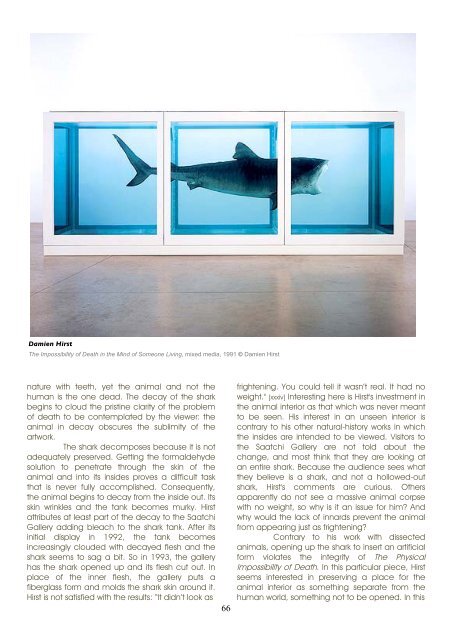Meet Animal Meat - Antennae The Journal of Nature in Visual Culture
Meet Animal Meat - Antennae The Journal of Nature in Visual Culture
Meet Animal Meat - Antennae The Journal of Nature in Visual Culture
You also want an ePaper? Increase the reach of your titles
YUMPU automatically turns print PDFs into web optimized ePapers that Google loves.
Damien Hirst<br />
<strong>The</strong> Impossibility <strong>of</strong> Death <strong>in</strong> the M<strong>in</strong>d <strong>of</strong> Someone Liv<strong>in</strong>g, mixed media, 1991 © Damien Hirst<br />
nature with teeth, yet the animal and not the<br />
human is the one dead. <strong>The</strong> decay <strong>of</strong> the shark<br />
beg<strong>in</strong>s to cloud the prist<strong>in</strong>e clarity <strong>of</strong> the problem<br />
<strong>of</strong> death to be contemplated by the viewer: the<br />
animal <strong>in</strong> decay obscures the sublimity <strong>of</strong> the<br />
artwork.<br />
<strong>The</strong> shark decomposes because it is not<br />
adequately preserved. Gett<strong>in</strong>g the formaldehyde<br />
solution to penetrate through the sk<strong>in</strong> <strong>of</strong> the<br />
animal and <strong>in</strong>to its <strong>in</strong>sides proves a difficult task<br />
that is never fully accomplished. Consequently,<br />
the animal beg<strong>in</strong>s to decay from the <strong>in</strong>side out. Its<br />
sk<strong>in</strong> wr<strong>in</strong>kles and the tank becomes murky. Hirst<br />
attributes at least part <strong>of</strong> the decay to the Saatchi<br />
Gallery add<strong>in</strong>g bleach to the shark tank. After its<br />
<strong>in</strong>itial display <strong>in</strong> 1992, the tank becomes<br />
<strong>in</strong>creas<strong>in</strong>gly clouded with decayed flesh and the<br />
shark seems to sag a bit. So <strong>in</strong> 1993, the gallery<br />
has the shark opened up and its flesh cut out. In<br />
place <strong>of</strong> the <strong>in</strong>ner flesh, the gallery puts a<br />
fiberglass form and molds the shark sk<strong>in</strong> around it.<br />
Hirst is not satisfied with the results: “It didn’t look as<br />
66<br />
frighten<strong>in</strong>g. You could tell it wasn’t real. It had no<br />
weight." [xxxiv] Interest<strong>in</strong>g here is Hirst's <strong>in</strong>vestment <strong>in</strong><br />
the animal <strong>in</strong>terior as that which was never meant<br />
to be seen. His <strong>in</strong>terest <strong>in</strong> an unseen <strong>in</strong>terior is<br />
contrary to his other natural-history works <strong>in</strong> which<br />
the <strong>in</strong>sides are <strong>in</strong>tended to be viewed. Visitors to<br />
the Saatchi Gallery are not told about the<br />
change, and most th<strong>in</strong>k that they are look<strong>in</strong>g at<br />
an entire shark. Because the audience sees what<br />
they believe is a shark, and not a hollowed-out<br />
shark, Hirst's comments are curious. Others<br />
apparently do not see a massive animal corpse<br />
with no weight, so why is it an issue for him? And<br />
why would the lack <strong>of</strong> <strong>in</strong>nards prevent the animal<br />
from appear<strong>in</strong>g just as frighten<strong>in</strong>g?<br />
Contrary to his work with dissected<br />
animals, open<strong>in</strong>g up the shark to <strong>in</strong>sert an artificial<br />
form violates the <strong>in</strong>tegrity <strong>of</strong> <strong>The</strong> Physical<br />
Impossibility <strong>of</strong> Death. In this particular piece, Hirst<br />
seems <strong>in</strong>terested <strong>in</strong> preserv<strong>in</strong>g a place for the<br />
animal <strong>in</strong>terior as someth<strong>in</strong>g separate from the<br />
human world, someth<strong>in</strong>g not to be opened. In this












